Study of interaction among organisms and between organisms and abiotic environment 4 levels of biological organisation- organism, population, communities and biomes.
Organisms and its Environment:

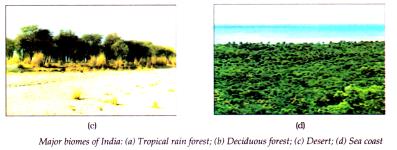
- All places on earth experience different temperature or seasons due to tilt axis of earth and revolution of earth around sun.
- Annual variation in precipitation and temperature results in biomes like deserts, rainforest and tundra.
- Life is also found in harsh habitats - Rajasthan desert, Meghalaya forest, ocean trenches, polar regions, mountain tops, torrential streams, thermal springs, compost pits etc.
- Difference in physical and chemical conditions is due to abiotic and biotic factors (pathogen, parasite, predators, competitors), with which they interact constantly.
- Each organism has defined range of conditions that it can tolerate, resources it utilises and functional role it plays in ecological system, all these comprise niche.

Major Abiotic Factors:
1. Temperature: Varies seasonally and affects kinetics of enzyme.
- Decreases from equator to poles and plain to mountains.
- ranges from subzero (polar areas and high altitude) to more than 50°C (deserts), however it exceeds 100°C in thermal springs and deep sea hydrothermal vents.
- Mango trees can’t grow in temperate countries like Canada and Germany, snow leopards aren’t found in
Kerala forest and tuna fish isn’t found beyond tropical in ocean.
Eurythermal: Organisms that can survive in wide range of temperature.
Stenothermal: Organisms that are restricted to narrow range of temperature.
2. Water: Limited availability, life originated in water.
- For aquatic animals, quality (pH, chemical composition) of water is important, many freshwater animals can’t live in sea water for long and vice-versa.
- Salt concentration (salinity in parts per 1000) - Less than 5 in inland water, 30 - 35 in sea, more than 100 in hypersaline lagoons.
Euryhaline: Organisms tolerant to wide range of salinities.
Stenohaline: Organisms restricted to narrow range of salinities.
3. Light: Linked to temperature as sun is source for both temperature and light.
- Many small herbs and shrubs overshadowed by canopied trees receive low light intensity but still able to survive as they adapt to synthesing food in low light.
- Diurnal and seasonal light variation and photoperiod signals animal to forage, migrate or reproduce whereas for plants its important for photosynthesis and photoperiod.
- UV component of spectrum is harmful whereas all other are available for marine plants. Organisms in deep oceans make use of different spectrum of light.
- Blue and green rays are absorbed by brown and red algae in deep waters.
4. Soil: Varies in different place.
- Nature and properties depend on climate, weathering process, parent rock and soil formation.
- Characteristic of soil like composition, grain size determine percolation and water holding capacity of soil whereas pH, topography, mineral composition determine vegetation.
Responses to Abiotic Factors:
- Organisms have evolved to maintain constant internal environment (within body) irrespective of outside environment (homeostasis) that permits all biochemical and physiological functions to proceed with maximum efficiency. eg. if person works best at 25°C, he could do same in hot or cold environment by switching on A.c. or heater in respective climates, but it doesn’t work for animals.
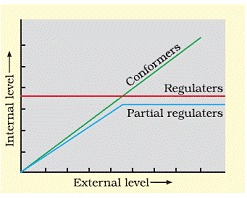
1. Regulate: Organisms which maintain homeostasis by physiological and behavioral means. (thermoregulation constant body temperature, osmoregulation - constant osmotic concentration).
- eg. birds, mammals, few lower vertebrate and invertebrate (not in plants).
- To maintain constant temperature of 37°C, humans sweat profusely in summer resulting in evaporative cooling to lower down body temperature whereas shiver in winters which produce heat and raise body temperature.
- Success of mammals is due to homeostasis which enable them to survive in Antarctica and Sahara desert.
2. Conform: 99% of animals can’t maintain homeostatis.
- Body temperature changes with external temperature, similarly osmotic concentration of body changes with concentration of water.
- Thermoregulation is expensive for these animals especially small animals which have large surface area relative to volume, so lose body heat quickly when outside temperature is low. They have to expend much energy to generate heat. That’s why small animals are rarely found in polar areas.
- Heat loss or heat gain is a function of surface area.
- If stressful conditions are for short time they migrate or suspend.
3. Migrate: Some organisms move from stressful to favourable area temporarily.
- Many birds from Siberia during winter undertake long distance migration to reach Keolado National Park (Bharatpur) in Rajasthan.
4. Suspend: Organisms who aren’t able to migrate, avoid stress by escaping time.
- Hibernation: During winter eg. bears; Aestivation - during summer eg. snails and fish (avoid dessication).
- Zooplankton species in lakes and ponds enter diapause (suspended development).
- In bacteria and fungi, thick walled spores are formed whereas plants reduce metabolic activity and enter dormancy in unfavourable conditions.
Adaptations: Attribute of organism that enable it to survive and reproduce in its habitat.
1. Morphological adaptations:
- Kangaroo rat in North American desert meets water requirement by metabolic water produced as by product during oxidation of fat. It can also concentrate its urine.
- Desert plants have thick cuticle on leaf with sunken stomata to minimise water loss. They have adopted special photosynthetic pathway (CAM) which keep stomata closed in day.
- Opuntia has no leaves as they are reduced to spines and photosynthesis occur by flattened stems (phylloclade)
- Allens’ Rule: Mammals in colder climate have short ears and limbs to prevent heat loss. Seals have thick layer of fat (blubber) below skin that acts as insulator and reduce loss of heat.
2. Physiological adaptations:
- At high altitude, person experience altitude sickness (nausea, fatigue and palpitations) due to low atmospheric pressure, but in some days it becomes normal as body increases RBC, reduces binding affinity of hemoglobin and increases breathing rate. That’s why tribe in Himalaya have high RBC content than people in plains.
- Archaebacteria survive in hot spring and deep sea hydrothermal vents where temperature is more than 100°C whereas many fish survive in Antarctic waters where temperature is below 0oC . Some fish live at great depths where pressure is 100 times more than atmospheric pressure.
3. Behavioural adaptations:
- Desert lizard maintains temperature by absorbing heat in sun when temperature is below normal whereas move into shade when temperature is high.
- Some species burrow in soil to escape above ground heat.
Populations:
Population attributes: eg. birth and death rates, sex ratio, age distribution, population density.
- Population: Individuals living in a group in a well defined geographical area, share or compete for similar resources, potentially interbreed. eg. bacteria in culture plate, lotus plants in ponds, teakwood trees in forest.
- Population attributes can’t be calculated for individuals.
(a) Birth and death rates: Change in no. (increase or decrease) with respect to members of populations.
- eg. if in a pond of 20 lotus plants, 8 more are added, birth rate =
= 0.4 individual per lotus plant/year.
In a week, if 4 out of 40 fruitfly die, death rate = = 0.1 individual per fruitfly per week.
(b) Sex ratio: Percentage of male or female in a population.
(c) Age distribution: Pre-reproductive, reproductive and post-reproductive.
Age pyramid: Graphical representation of different age groups.

(i) Expanding: Growing population, more natality less mortality.
(ii) Stable: No increase no decrease, natality = mortality.
(iii) Declining: Decreasing population, more mortality less natality.
(d) Population density:
- Refers to population size but not necessary in number (which is sometimes meaningless).
- If single huge banyan tree grows among 200 parthenium plants it would be incorrect that population density of banyan tree is low. In such cases, percent cover/biomass is meaningful.
- Sometimes, counting is impossible or time consuming so relative densities are considered. eg. fish caught per trap gives measure of population density in lake.
- Sometimes, its calculated indirectly. eg. tiger census in parks is based on pug marks and fecal pellets.
Population growth: Size of population isn’t static and keeps on changing.
Natality (B): No. of births in the population that are added to the initial density in given period.
Mortality (D): No. of deaths during given period.
Immigration (I): No. of individuals of some species that come from elsewhere in given period.
Emigration (E): No. of individuals of a population that go elsewhere during a given period.
- Natality and Immigration increase population but mortality and emigration decrease population.
- Births and deaths are important under normal conditions.
- Let ‘N’ be population density at time ‘t’, then density at time ‘t + 1’-
N t+1 = Nt + [(B + I) - (D + E) ]
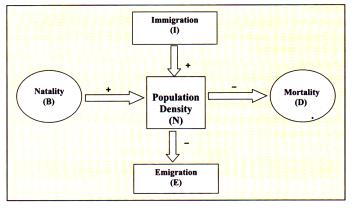
Growth models:
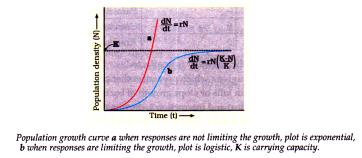
1. Exponential growth:
- Population grows exponentially/geometrically (J-shaped) if resources are unlimited and species have ability to realise fully its innate potential to grow in number - DARWIN.
- Population size = N, birth rates = b, death rates = d
r = intrinsic rate of natural increase, increase/ decrease in ‘N’ during time period ‘t’
Let r = (b - d)
- Integral form: Nt = Noert where Nt = population density at ‘t’; No = initial population density; e = base of natural logarithms; r = intrinsic rate of natural increase.
- Norway rat: r = 0.015; flour beetle: r = 0.12; human (in 1981) : 0.0205.
2. Logistic growth or Verhulst - Pearl Logistic Growth: More realistic
- Resources are limited which leads to competition between individuals and fittest one survive and reproduce.
- Population initially shows lag phase, then acceleration and deacceleration and finally asymptote, when
- Density reaches carrying capacity (k) - sigmoid curve.
K= carrying capacity (given habitat has enough resources to support maximum possible number, beyond which no growth is possible).
- ‘r’ is important for studying impacts of biotic or abiotic factor on population growth.
Life History Variation:
- Some organisms breed only once in their lifetime - Pacific salmon fish, bamboo.
- Some produce large no. of small size offspring-oysters, pelagic fish while some produce small no. of large
- size offspring- birds, mammals .
Population Interactions:

- Animals, plants and microbes can’t live in isolation but interact in various ways to form biological community.
- Interspecific interaction: Interaction between population of different species. It can be beneficial, detrimental or neutral to both species or one of them.
- In predation, parasitism and commensalism, interacting species live together closely.
- (+) ® beneficial interaction; (-) ® detrimental; ® 0 neutral
1. Amensalism: One species is harmed whereas other is unaffected.
eg. (a) Walnut tree exerts a substance juglone which prevents other plant to grow as it damages their roots.
(b) Penicillin secreted by Penicillium kills or stops growth of bacteria.
2. Predation: One species benefits (predator) and interaction is detrimental to other (prey).
- Predators transfer energy to higher trophic levels and keep prey population under control, as prey would achieve high population density and cause ecosystem instability. They reduce competitions among prey species and maintain species diversity.
- Predators are prudent as it can overexploit its prey and prey might extinct, eventually predators will extinct due to lack of food.
- eg. (a) Prickly pear cactus when introduced in Australia caused havoc by spreading rapidly and was brought under control when cactus feeding moth was introduced.
(b) When starfish Pisaster in American Pacific Coast was removed, more than 10 species of invertebrates became extinct due to interspecific competition, in just 1 year.
- Prey species have evolved defenses eg. some insects and frogs camouflage to avoid being detected. Some are poisonous eg. Monarch butterfly acquires a chemical during caterpillar stage by feeding on poisonous weed which is highly distasteful to bird.
- 25% insects are phytophagous (feed on plant sap and other parts of plant)
- Plants have morphological and chemical defences against herbivores.
eg. thorns in Acacia, Cactus; Calotropis produce highly poisonous cardiac glycosides to prevent browsing of cattle or goats near it.
- Some plants produce nicotine, caffeine, quinine, strychnine, opium against grazers and browsers.
3. Competition
Fitness of one species is lower in presence of another species.
- Darwin: Inter specific competition is a potent force in evolution.
- Unrelated species also compete for resources. eg. flamingoes and resident fish of South America compete for zooplankton in the lake.
- Sometimes limited resources don’t lead to competition as feeding efficiency of one species reduce due to presence of another species.
- Gause’s: In limited resources, superior species eliminate the other species.
- eg. Abingdon tortoise in Galapagos became extinct after introduction of goats as goats had greater browsing efficiency.
- Gause’s ‘Competitive Exclusion Principle: 2 closely related species competing for same resource can’t co-exist and competitively inferior one gets eliminated, if resources are limited but not otherwise.
- Competitive release: Species whose distribution is restricted to a particular area due to presence of superior species and would expand its range when competing species is removed.
- Connell’s elegant field experiment: Superior barnacle Balanus on rocky sea coasts of Scotland excludes small barnacle Chathamalus.
- Resource partitioning: Mechanism to promote co-existence rather than exclusion, by choosing different times for feeding or foraging patterns. Mac Arthur showed 5 spices of warblers on same tree co-existed due to differences in foraging activities.
4. Parasitism:
Parasite is benefitted but detrimental for host.
- Many parasite have become host specific which lead to co-evolution of both parasite and host, i.e. if host develops special mechanism for resisting parasite, parasite also evolves mechanism to neutralise it.
- Parasites have evolved special adaptations -loss of digestive system and other sense organs, high reproduction ability, presence of adhesive sucker to cling on to host.
- Some parasites make host more susceptible to predation by making them physically weak, reduce growth, survival and reproduction and reduce population size.
- Some parasites have complex life as they depend on intermediate hosts. eg. human liver fluke (nematode Parasite) depends on 2 hosts (snail and fish) to complete its life cycle.
- Ectoparasite: Parasite that feed on surface of host. eg. ticks on dogs , lice on human, Cuscuta on hedge plant (lost its chlorophyll).
- Endoparasite: Parasite that live inside host body, have complex life cycles. eg. tapeworm.
- Female mosquito isn’t a parasite although it needs blood for reproduction.
- Brood parasitism: Parasitic bird lays eggs in nest of host so that host can incubate them. During course of evolution, eggs of parasitic bird resembles host’s egg in size and colour to reduce chances of being identified and ejected.
5. Commensalism:
One species benefits while other is neither harmed nor benefited.
eg. (a) Orchid as epiphyte on mango tree (neutral- mango tree)
(b) Barnacles on back of whale (neutral- whale)
(c) Egrets and cattle - egrets forage close to cattle as cattle moves and flushes out insects from vegetation, which are difficult for egrets to catch.
(d) Sea anemor and clown fish- Clown fish live among the stinging tentacles of sea anemore and hence get protected.
6. Mutualism:
Benefits to both the species interacting.
eg. (a) Lichen: Algae and fungi, algae provides food and fungi provide shelter.
(b) Mycorrhizae: Fungi and plant roots, fungi absorb nutrients from soil and plant provides food in form of carbohydrates.
(c) Plant take help from insects and animal for pollination and seed dispersal and in return provide juicy nectars, nutritious fruits, pollen. But some animals try to steal nectar without aiding in pollination.
(d) Fig species can only be pollinated by wasp species. Wasp serves as pollinator while fruit serves as oviposition (egg laying site). Developing seeds inside fruit provide nutrition to growing larvae.
(e) Mediterranean orchid ophrys (sexual deceit): Pollinated by bee species. One of the petal of the flower resembles female bee in size, colour and markings, so male bee gets attracted and pseudocopulates the flower and during this pollens from flower get dusted on it. When same bee pseudocopulates other flower, it transfers pollen, hence co-evolution occur. Not all orchids offer rewards. If female bee’s colour pattern changes, chances of pollination reduce.
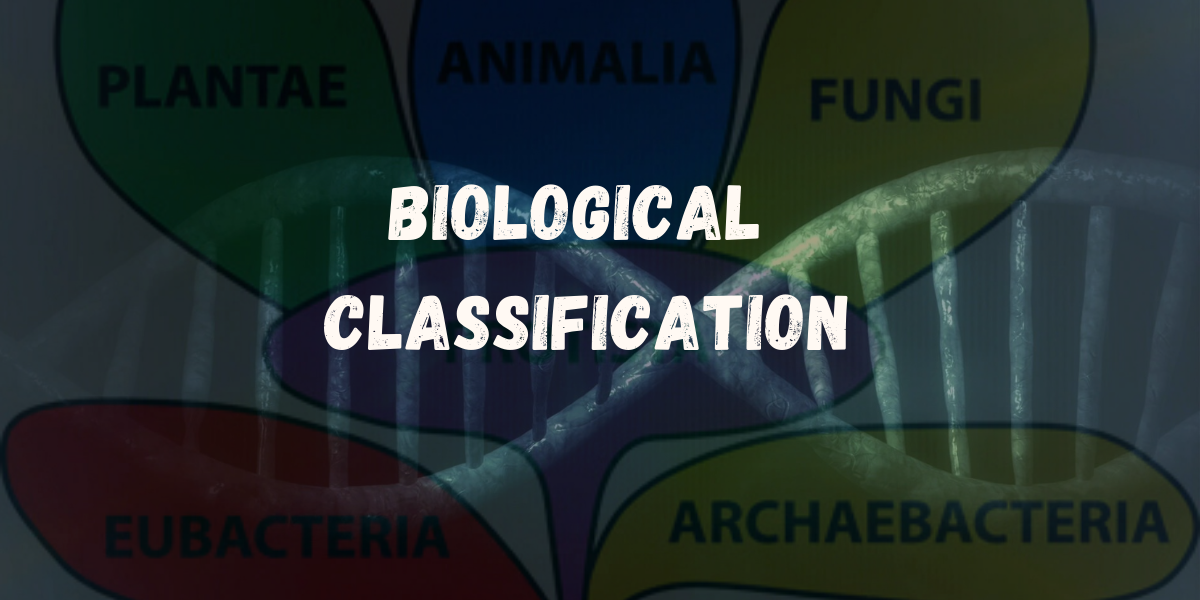
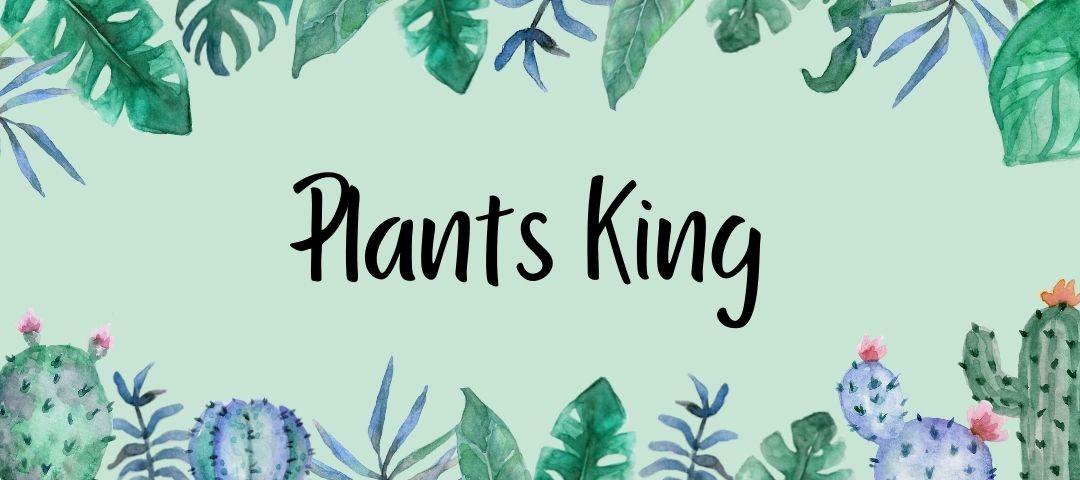
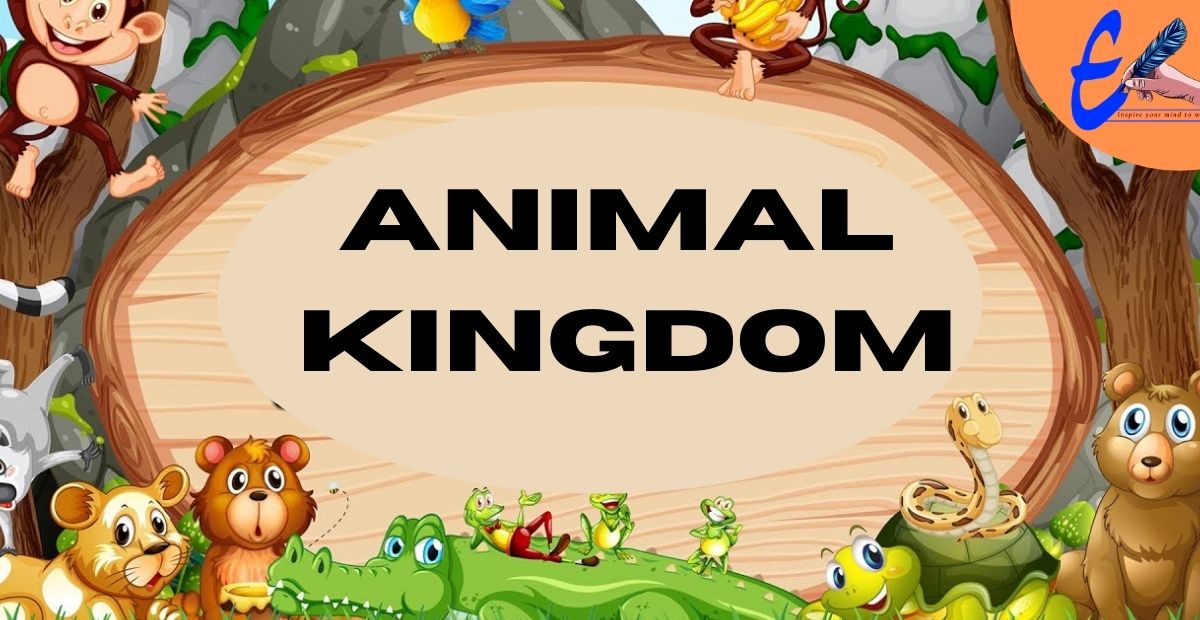
… [Trackback]
[…] Read More here to that Topic: eklabhyaclasses.com/blog/organism-and-population/ […]
… [Trackback]
[…] Read More on to that Topic: eklabhyaclasses.com/blog/organism-and-population/ […]
… [Trackback]
[…] Read More on to that Topic: eklabhyaclasses.com/blog/organism-and-population/ […]
… [Trackback]
[…] There you can find 59273 additional Information to that Topic: eklabhyaclasses.com/blog/organism-and-population/ […]
… [Trackback]
[…] Find More to that Topic: eklabhyaclasses.com/blog/organism-and-population/ […]
… [Trackback]
[…] Read More Information here to that Topic: eklabhyaclasses.com/blog/organism-and-population/ […]
… [Trackback]
[…] Read More Info here on that Topic: eklabhyaclasses.com/blog/organism-and-population/ […]
… [Trackback]
[…] Find More on that Topic: eklabhyaclasses.com/blog/organism-and-population/ […]